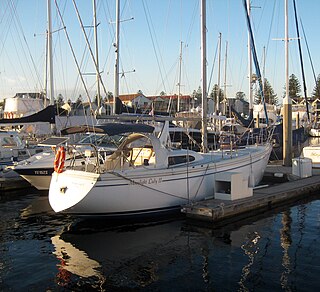Related Research Articles
The US Yachts US 25 is an American trailerable sailboat, that was designed by Gary Mull and first built in 1981. The design is out of production.

The CS 22 is a Canadian trailerable sailboat, that was designed by John A. Butler and first built in 1971. The design is out of production.

The Catalina 250 is an American trailerable sailboat, that was designed by the Catalina Design Team and first built in 1995.
The Watkins 23 is an American trailerable sailboat that was designed by Johannes "Jopie" Helsen, modified by Watkins Yachts and first built in 1973.

The Columbia 34 Mark II is an American sailboat that was designed by William H. Tripp Jr. as a coastal cruising sailboat and first built in 1970.
The Columbia 38 is an American sailboat that was designed by Charles Morgan as racer-cruiser and first built in 1965.
The Sabre 38 is an American sailboat that was designed by Roger Hewson and the Sabre Design Team as a racer-cruiser and first built in 1981.
The Bristol Caravel 22, sometimes called the Bristol 22 Caravel, Sailstar Caravel, or just the Caravel 22, is an American trailerable sailboat that was designed by Halsey Chase Herreshoff as a cruiser and first built in 1968. It is named for the class of sailing ship.
The Captiva 240 is an American trailerable sailboat that was first built in 1984. The boat is a development of the O.H. Rodgers-designed Rodgers 24 racer, modified for use as a racer-cruiser by Walter Scott by giving it a new keel and sailing rig.
The Columbia 22 is an American trailerable sailboat that was designed by William Crealock and first built in 1966.
The Coronado 23, also called the Sailcrafter 23, is an American trailerable sailboat that was designed by William Crealock as cruiser-racer and first built in 1969.
The Coronado 25 is an American trailerable sailboat that was designed by Ed Edgar and Frank W. Butler as a cruiser and first built in 1966.
The Ericson 23-2 is an American trailerable sailboat that was designed by Bruce King as a cruiser and first built in 1975.
The Irwin 23 is an American trailerable sailboat that was designed by Ted Irwin as a cruiser and first built in 1968.
The Irwin 25 is an American trailerable sailboat that was designed by Ted Irwin as a cruiser and first built in 1969.
The Morgan 22 is an American trailerable sailboat that was designed by Charley Morgan as a racer-cruiser and first built in 1968.
The Pearson 23 is an American trailerable sailboat that was designed by William Shaw as a cruiser and first built in 1978.
The Seafarer 24 is an American trailerable sailboat that was designed by McCurdy & Rhodes as a cruiser and first built in 1974.
The Seafarer 29 is an American sailboat that was designed by McCurdy & Rhodes as an International Offshore Rule Half Ton class racer-cruiser and first built in 1972.
The Slipper 17 is an American trailerable sailboat that was designed by Nick Hake as a pocket cruiser and first built in 1981.
References
- 1 2 3 4 5 6 McArthur, Bruce (2022). "Spirit 23 sailboat". sailboatdata.com. Archived from the original on 25 February 2022. Retrieved 25 February 2022.
- 1 2 McArthur, Bruce (2022). "Spirit 23 K sailboat". sailboatdata.com. Archived from the original on 25 February 2022. Retrieved 25 February 2022.
- ↑ McArthur, Bruce (2022). "Robert Finch". sailboatdata.com. Archived from the original on 25 February 2022. Retrieved 25 February 2022.
- 1 2 3 4 5 6 7 8 9 Henkel, Steve: The Sailor's Book of Small Cruising Sailboats, page 206. International Marine/McGraw-Hill, 2010. ISBN 978-0-07-163652-0
- 1 2 McArthur, Bruce (2022). "North American 23 sailboat". sailboatdata.com. Archived from the original on 25 February 2022. Retrieved 25 February 2022.
- ↑ McArthur, Bruce (2022). "Glastron". sailboatdata.com. Archived from the original on 24 February 2022. Retrieved 25 February 2022.